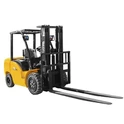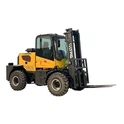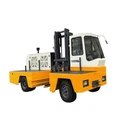"I need a forklift"-this might be the first reaction of many independent sellers and warehouse managers when purchasing material handling equipment. But when faced with a wide variety of products on the market, a question often arises: Is that seemingly compact "pallet stacker" designed for stacking and palletizing a forklift? The similarities in appearance and some functions between the two often lead to confusion. However, there are fundamental differences between them, from legal definitions to operational requirements to application scenarios. Making the wrong choice can not only waste money but also create safety risks. This article will provide an in-depth analysis to help you understand the practical differences and key purchasing considerations once and for all.

Core Definition: Different "Identities" Under Legal and Industry Standards
Before discussing their functions, we must first clarify one point: Under safety regulations in many countries and regions (such as OSHA in the United States), pallet stackers are explicitly classified as a type of forklift, falling under the category of "powered industrial trucks."
This means that despite their simplified appearance and functionality, they are often subject to similar regulations as traditional forklifts in terms of safety training, operator qualifications, and maintenance standards. Simply viewing a stacker as a "large hydraulic truck" is a common but dangerous misconception.
However, in everyday communication and procurement contexts, the industry generally distinguishes between the two because their design intent and core uses are distinct.
Functional Comparison: A Battle Between "Specialists" and "Generalists"
Pallet Stacker Cranes' Core Function: Maximizing Vertical Space Utilization
- Design Core: Designed specifically for vertical stacking of pallets. The essence of its design lies in "stacking," not "lifting."
- Fork Structure: Forks are typically fixed or have only a narrow range of adjustment, primarily performing precise up and down movements. They typically have "straddle legs" underneath to balance the load, making them primarily suitable for standard pallets.
- Load Capacity and Height: Load capacities are relatively concentrated, generally between 1 and 2 tons, and the ideal lift range is typically 2 to 5 meters. This perfectly matches the storage needs of most standard racks.
Core Functions of a Forklift: Versatile Horizontal and Vertical Material Handling
- Core Design: Combining lifting and moving with stacking. It's a comprehensive material handling machine.
- Fork Flexibility: The iconic mast can tilt forward and backward, and the forks can be shifted left and right. This allows for greater maneuverability when loading and unloading, easily navigating uneven surfaces or truck beds.
- Performance Range: The forklift offers a wide range of load capacities, from lightweight electric forks (1 ton) to heavy-duty container forks (over 40 tons). It's powerful powertrain and sturdy chassis enable it to handle not only high stacking but also long-distance, high-intensity material transfers.
| Dimension | Pallet Stacker | Counterbalance Truck |
|---|---|---|
| Primary Tasks | Vertical stacking & shelf replenishment | All-round handling, loading/unloading & long-distance transport |
| Fork Functions | Mainly lift | Lift, tilt forward/backward, side-shift (optional) |
| Typical Capacity | 1–2 t | 1–10+ t |
| Typical Lift Height | 2–5 m | 3–7+ m |
| Suitable Loads | Standard palletized goods | All pallets, loose cargo & irregularly-shaped loads |
Operation Methods and Scenarios: Using the Right Equipment in the Right Place
Pallet Stackers: The "Sprinters" of the Aisle
- Operation Method: Typically available in walkie or ride-on configurations, the operator handle integrates all functions, including lift, forward and reverse, for an intuitive and easy-to-understand experience.
- Mobility and Turning: A very tight turning radius is their core advantage. They can maneuver effortlessly through narrow aisles, where traditional forklifts cannot reach.
Applicable Scenarios:
- Small Standalone Warehouses: Warehouses with limited space and densely packed shelves.
- Floor Warehouses or Mezzanines: Areas with high floor load-bearing requirements.
- End of Line: Palletizing and temporarily storing finished products after they leave the production line.
- Back of House: Quickly and quietly replenishing shelves.
Forklifts: The "Long-Distance Champions" of the Site
- Operation: Sit-down, equipped with a steering wheel, accelerator, brake, and multiple hydraulic levers, their operation is far more complex than a stacker.
- Regulatory Requirements: Professional training and a nationally or regionally recognized operator certification are mandatory.
Applicable Scenarios:
- Large Warehouses: High cargo volumes require frequent inbound and outbound operations and long-distance transfers.
- Truck/Container Loading and Unloading: Whether loading from the side or rear dock, a forklift's flexibility and power are essential.
- Outdoor or Harsh Environments: Diesel or LPG forklifts offer greater power and environmental adaptability.
- Handling Heavy or Non-Standard Cargo: By adapting various attachments, it can handle paper rolls, oil drums, large molds, and more.
Cost and Efficiency: An Economic Account That Needs to Be Clearly Calculated
| Dimension | Pallet Stacker | Forklift |
|---|---|---|
| Equipment Purchase Cost | Low-usually 1/3 to 1/2 the price of a forklift of the same capacity. | High price rises with added functionality. |
| Maintenance Cost | Simple structure, mostly electric; few service items → low cost. | Complex (engine/battery, hydraulics); high service demands → higher cost. |
| Operator Training Cost | Requires safety training but usually no mandatory national certification; short training cycle and low cost. | Mandatory licensing: training, testing, and annual renewal → high administrative cost. |
| Energy Cost | Mainly electric, easy to charge; electricity is far cheaper than fuel, and operation is quiet & emission-free. | Electric, diese,l or LPG; fuel cost (especially diesel) fluctuates significantly. |
| Operating Efficiency | Extremely high in specific scenarios (e.g., narrow-aisle stacking). | Strong overall efficiency, but performance drops in confined spaces. |
Purchasing Recommendations: Your Needs Determine the Ultimate Choice
When a Pallet Stacker Crane is Highly Recommended:
- Core Operation: "Racking": 90% of your work involves precisely placing pallets from the floor onto shelves.
- Narrow Warehouse Aisles: Aisles less than 2.5 meters wide make traditional forklifts difficult to operate.
- Limited Budget: You want to solve core vertical storage problems with a low initial investment.
- High Operator Mobility: You want quick employee onboarding and a low training threshold (although safety training is still essential).
- High Indoor Environmental Requirements: You require zero-emission, low-noise equipment.
When a Forklift is Essential:
- Frequent Truck Loading and Unloading: This is a "must-have" scenario for a forklift; a stacker crane is not up to the task.
- Long Distances: Goods need to be transported long distances between different areas of the warehouse (e.g., from the receiving area to the storage area).
- Large or Irregular Goods: You frequently handle loads exceeding 2 tons or require specialized attachments to handle non-standard goods.
- Have a professional logistics team: Have a budget and system to manage the professional maintenance of certified operators and equipment.
Safety First: The Red Line That Cannot Be Crossed
- To reiterate the key point: No matter which equipment you choose, safety always comes first.
- Compliance Training: Ensure every operator receives professional safety training specific to the equipment they operate. Even if regulations don't mandate certification for stackers, internal training and authorization are essential.
- Daily Inspection: Establish a pre-shift equipment inspection system to check brakes, steering, lifting systems, battery/fuel levels, etc.
- Strictly Observe Load Capacity: Never overload! Understand the equipment's load curve and understand the relationship between lift and load capacity.
- Standard Operation: Strictly prohibit dangerous behaviors such as carrying people on the forks, raising the forks too high while operating, and driving sideways on slopes.
Conclusion
Back to the original question: Is a pallet stacker considered a forklift? From a regulatory perspective, the answer is "yes." It should be treated as a simplified, specialized forklift for safety management. However, from a functional and purchasing perspective, it should be considered a separate category-the aisle stacking specialist.
For budget-conscious customers, a clear understanding of the differences between pallet stackers and forklifts means you can invest your limited funds in equipment that best addresses your core needs. Don't overpay for unnecessary features, and don't sacrifice efficiency and safety for cheapness. Make the smartest choice based on your warehouse layout, operational processes, and future growth.







